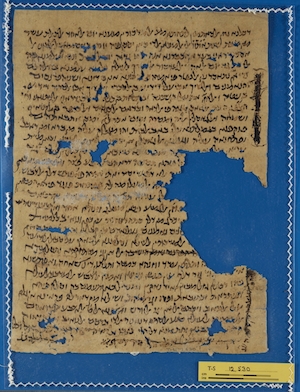T-S 12.530: A day in the life of a court scribe
The handwriting of the 12th-century court scribe Ḥalfon ben Manasseh is preserved in more Genizah manuscripts than any other individual. He wrote thousands of legal deeds and letters, and these documents are a fascinating window into Jewish jurisprudence and the social and communal affairs of the Jewish community in medieval Fusṭāṭ (Old Cairo). Ḥalfon was the son-in-law, student, and eventual successor to the court scribe Hillel ben Eli, and dated documents are found in his handwriting from 1100-1138 CE. Although we have many documents written in his own hand, most of these manuscripts are court records dealing with other individuals, and not a great deal is known of the daily activities of Ḥalfon himself.
Cambridge University Library T-S 12.530 recto: A court record written by Ḥalfon ben Manasseh
T-S 12.530 is a court record written by Ḥalfon, describing events in the year 1105 CE in which Ḥalfon himself took part. It is a report in Judaeo-Arabic concerning the discovery of the body of Joseph b. Ismāʿīl al-Būnī the Alexandrian. Joseph had no relatives and lived alone. Someone must have noticed the man's absence from his normal routine, and this was reported to community leaders. A delegation, including Ḥalfon, was deployed to investigate the matter. Finding Joseph’s front door locked (‘from the outside and from the inside’), and perhaps detecting the scent of something untoward, the men broke down the door and discovered Joseph’s remains. In the absence of any readily-identifiable relatives, the officials called the washers of the dead to remove Joseph’s body and prepare it for burial.
They then turned their attention to the deceased’s property (which is listed on the verso of the document). Valuables, including a large copper cauldron and cash in silver and gold, were taken for safekeeping, after the sum of 6 dinars was deducted for funeral expenses. Joseph’s non-valuable possessions, including various textiles and a basket, were locked in the house until an heir could come forth to claim them. The court record is signed by Isaac ben Samuel, ʿUlla ha-Levi ben Joseph, and several others, but the signatures are crossed out, as is the signature of Ḥalfon himself in the margin.
Cambridge University Library T-S 12.530 verso: Inventory of the possessions found in the house of the deceased Joseph b. Ismāʿīl al-Būnī in the hand of Ḥalfon ben Manasseh
Bibliography
Goitein, S.D. 1988. A Mediterranean Society, Vol.5: The Individual, pp. 158-160. Berkeley - Los Angeles - London: University of California Press.
Weiss, G. 1970. Legal documents written by the court clerk Halfon ben Manasse (dated 1100-1138): A study in the diplomatics of the Cairo Geniza, Documents 46 and 47. PhD Thesis. University of Pennsylvania.
Cite this article
(2014). T-S 12.530: A day in the life of a court scribe. [Genizah Research Unit, Fragment of the Month, September 2014]. https://doi.org/10.17863/CAM.7802
Contact us: genizah@lib.cam.ac.uk
The zoomable images are produced using Cloud Zoom, a jQueryimage zoom plugin:
Cloud Zoom, Copyright (c) 2010, R Cecco, www.professorcloud.com
Licensed under the MIT License


